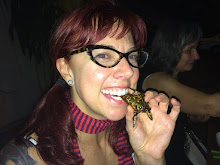Many people don't know this, but the whole National Breast Cancer Awareness Month (NBCAM) is fully funded by Imperial Chemical Industries (ICI) in a multi-million dollar deal made with National Breast Cancer Foundation (NBCF) and Estee Lauder (who originally used the ribbon as their company symbol). Why does this matter? Well, ICI happens to be the maker of not only Tamoxifen (the leading drug treatment for breast cancer) but of plastics and insecticides that cause cancer. Since most breast cancers are estrogen based, Tamoxifen works by blocking estrogen receptors (this was discovered through pesticide development and refined into the compound comprising today's Tamoxifen). Unfortunately, it also leaves the woman getting treated more open to getting other types of cancers and increases menopausal symptoms, but hey, most drugs have some sort of unpleasant side effects right?
What is even more amazing is that with their political pull (much money is spent on lobbying), ICI has somehow gotten the FDA to approve Tamoxifen drug trials on healthy women as a cancer prophylactic! They're also encouraging pre-menopausal mammograms, which has previously been established as unnecessary unless you have genetic predisposition. Hello, it's radiation folks. Radiation causes cancer. Isn't that what we're all trying to avoid here? Why would you introduce it to women who are unlikely to need exposure as a preventative measure?
So basically, all those pink spatulas, key chains, and cruise ships are making a profit off of people's fear. Yes, a very small percentage does go towards research, but if you look at the politics behind it and the little amount of actual money that's benefiting women, there must be other ways to deal with this disease. Not to mention that the carcinogens produced to make these anti-cancer awareness products cause cancer. It should also be noted that, as per usual, the way to get women's attention is via the marketplace. Because all women like to shop, right? I don't see men being encouraged to buy wallets or blenders with a blue ribbon logo for prostate cancer awareness.
When I was working as a Program Director for Women's Health Network (a breast and cervical cancer detection program for low-income women), I really struggled with the promotion I was expected to do during October. Of course, I wanted women to be aware of their health needs and provide accessibility to cancer detection services and care, but the more I learned about how the whole awareness operation worked, the less I wanted to contribute to it. Even the water bottles that were provided by the state for promotion were plastic bottles that had vinyl chloride (which causes pseudo estrogens which cause estrogen based cancers). By ignoring the environmental factors and pushing women to get yearly mammograms to "prevent cancer" (they detect it, not prevent it - and for most post-menopausal women, once every other year is sufficient) I felt like the message to women was always that they were somehow responsible for their disease ("if you don't get a mammogram, you'll get cancer") and that carcinogens were a moot issue. Anyone who reads the Silent Springs study (study of breast cancer being 20% higher in Cape Cod than in the rest of the country) would beg to differ. In fact, the leading cause of breast cancer is environment... not genetics. And drug, chemical, and biotechnology companies have a vested interest in treating the disease rather than finding ways to minimize its rate of incidence.
Most people also seem unaware that breast cancer is NOT the number one killer of women in the US. The winner in this category is Cardiovascular Disease (CVD). Though genetics play some part, CVD can be prevented for most people through lifestyle changes. But most of the money, lobbying (millions in lobbying dollars), and awareness goes to breast cancer, so cancer gets all the attention while most women are dying quick, silent deaths partially because they don't even know the symptoms of a WOMAN's heart attack. Because the symptoms are different than men's symptoms (though, not surprisingly, only men's symptoms are common knowledge), they are often fatal because they are unrecognized and thus untreated.
So though breast cancer is an awful disease (and preventable for some, if policies would address environmental issues), buying something pink doesn't mean you're doing diddley to prevent women from dying. The wash of pink is essentially like SOMA in A Brave New World, it makes you feel better, like you're helping the cure, but really you're just being placated. Awareness and women supporting each other in what was once a hush-hush disease because it affects a part of the body that's normally most noted for its sexuality (forgetting that it also provides nourishment for the next generation of babies) is wonderful. But if more energy were put into demands for tighter restrictions on toxin releases into the environment and less on what style pink teddy bear to buy, we'd have a lot less deaths to go on Avon sponsored walks for.
If this is new information for you, please pass this on to everyone you know. Every October, I get my panties in a wad over this. It's time this was common information.
This is a very(!) brief overview of the travesty that is Breast Cancer Awareness Month. However, you can find more detailed information at:




